Mount Isa Hospital: Organizational Problems in Social Work
VerifiedAdded on 2023/04/05
|10
|2690
|324
Report
AI Summary
This report analyzes the organizational challenges faced by Mount Isa Base Hospital (Mental Health) in Queensland, Australia, a human service organization (HSO) serving a significant Aboriginal population. The central argument highlights the need for organizational stability to improve mental health care delivery, particularly for the Indigenous community, which is disproportionately affected by substance abuse and cultural sensitivities around mental health. The primary problem identified is the frequent turnover of doctors, social workers, and counselors, which disrupts service delivery and hinders patient care. The report discusses the hospital's context, including its divisional organizational structure and the impact of staff instability on both direct and indirect task environments. It emphasizes the crucial role of social workers as agents of change, advocating for culturally appropriate care and influencing government decisions to foster organizational stability. The report explores the opportunities and constraints social workers face in addressing these issues, aiming to improve the hospital's ability to provide effective mental health services to the Aboriginal and Torres Strait Islander communities.
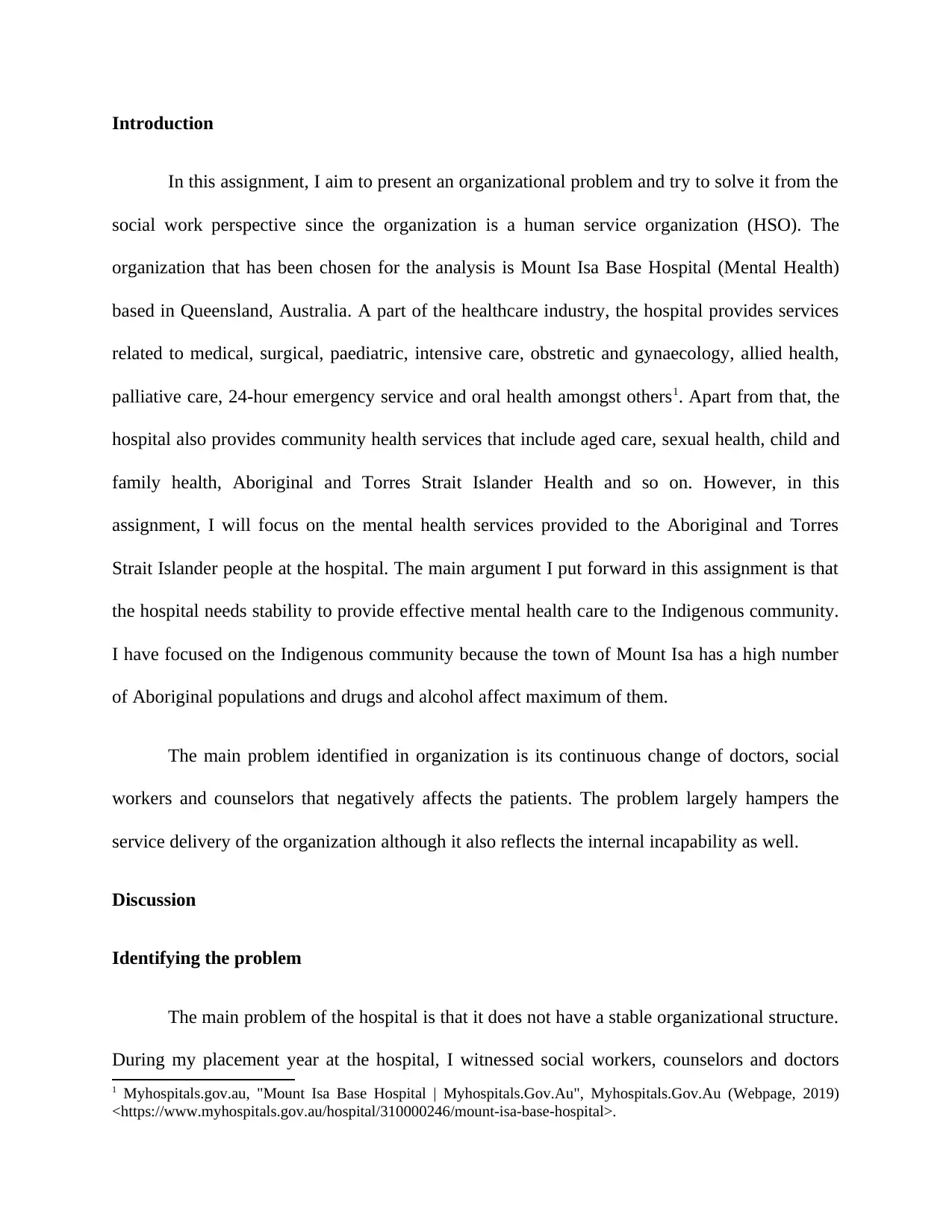
Introduction
In this assignment, I aim to present an organizational problem and try to solve it from the
social work perspective since the organization is a human service organization (HSO). The
organization that has been chosen for the analysis is Mount Isa Base Hospital (Mental Health)
based in Queensland, Australia. A part of the healthcare industry, the hospital provides services
related to medical, surgical, paediatric, intensive care, obstretic and gynaecology, allied health,
palliative care, 24-hour emergency service and oral health amongst others1. Apart from that, the
hospital also provides community health services that include aged care, sexual health, child and
family health, Aboriginal and Torres Strait Islander Health and so on. However, in this
assignment, I will focus on the mental health services provided to the Aboriginal and Torres
Strait Islander people at the hospital. The main argument I put forward in this assignment is that
the hospital needs stability to provide effective mental health care to the Indigenous community.
I have focused on the Indigenous community because the town of Mount Isa has a high number
of Aboriginal populations and drugs and alcohol affect maximum of them.
The main problem identified in organization is its continuous change of doctors, social
workers and counselors that negatively affects the patients. The problem largely hampers the
service delivery of the organization although it also reflects the internal incapability as well.
Discussion
Identifying the problem
The main problem of the hospital is that it does not have a stable organizational structure.
During my placement year at the hospital, I witnessed social workers, counselors and doctors
1 Myhospitals.gov.au, "Mount Isa Base Hospital | Myhospitals.Gov.Au", Myhospitals.Gov.Au (Webpage, 2019)
<https://www.myhospitals.gov.au/hospital/310000246/mount-isa-base-hospital>.
In this assignment, I aim to present an organizational problem and try to solve it from the
social work perspective since the organization is a human service organization (HSO). The
organization that has been chosen for the analysis is Mount Isa Base Hospital (Mental Health)
based in Queensland, Australia. A part of the healthcare industry, the hospital provides services
related to medical, surgical, paediatric, intensive care, obstretic and gynaecology, allied health,
palliative care, 24-hour emergency service and oral health amongst others1. Apart from that, the
hospital also provides community health services that include aged care, sexual health, child and
family health, Aboriginal and Torres Strait Islander Health and so on. However, in this
assignment, I will focus on the mental health services provided to the Aboriginal and Torres
Strait Islander people at the hospital. The main argument I put forward in this assignment is that
the hospital needs stability to provide effective mental health care to the Indigenous community.
I have focused on the Indigenous community because the town of Mount Isa has a high number
of Aboriginal populations and drugs and alcohol affect maximum of them.
The main problem identified in organization is its continuous change of doctors, social
workers and counselors that negatively affects the patients. The problem largely hampers the
service delivery of the organization although it also reflects the internal incapability as well.
Discussion
Identifying the problem
The main problem of the hospital is that it does not have a stable organizational structure.
During my placement year at the hospital, I witnessed social workers, counselors and doctors
1 Myhospitals.gov.au, "Mount Isa Base Hospital | Myhospitals.Gov.Au", Myhospitals.Gov.Au (Webpage, 2019)
<https://www.myhospitals.gov.au/hospital/310000246/mount-isa-base-hospital>.
Paraphrase This Document
Need a fresh take? Get an instant paraphrase of this document with our AI Paraphraser
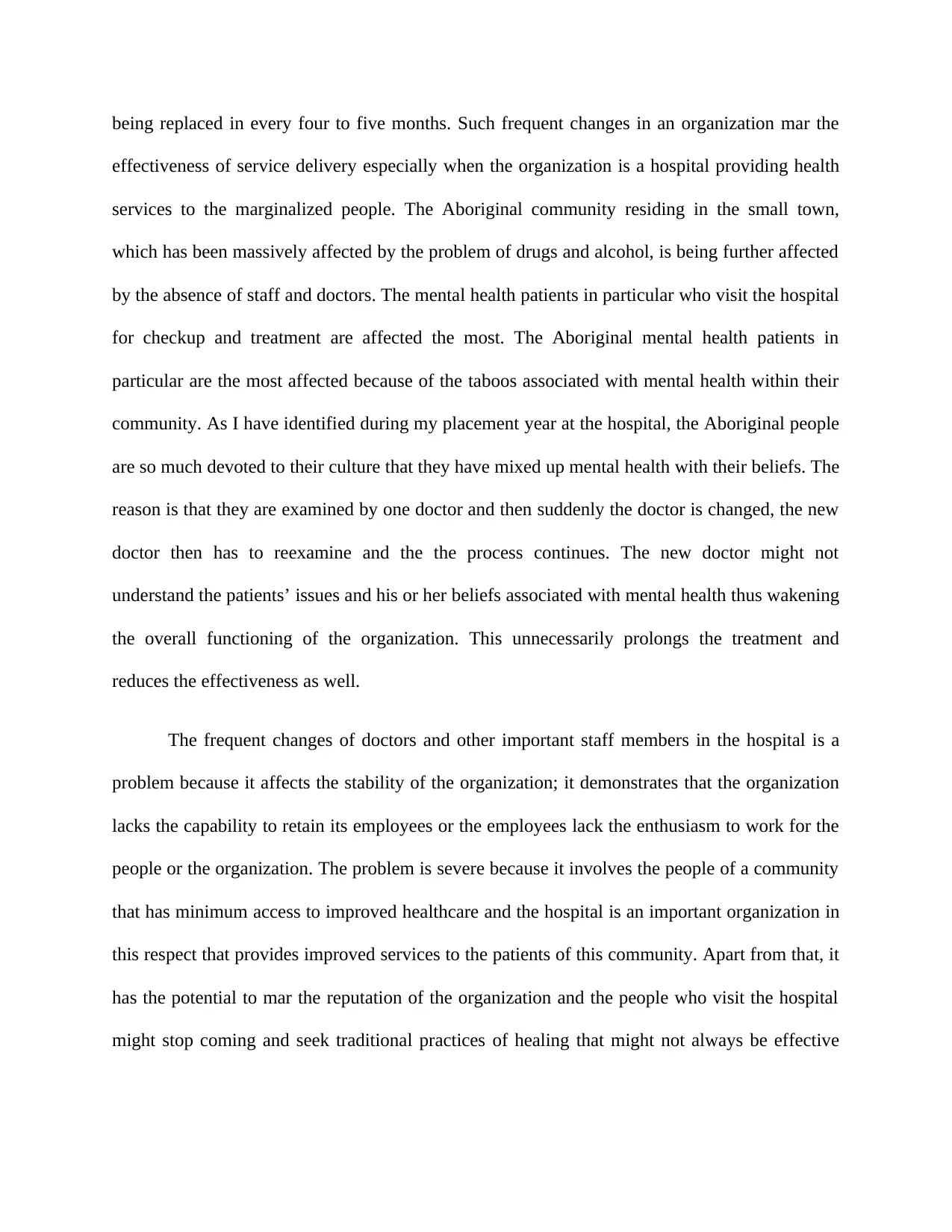
being replaced in every four to five months. Such frequent changes in an organization mar the
effectiveness of service delivery especially when the organization is a hospital providing health
services to the marginalized people. The Aboriginal community residing in the small town,
which has been massively affected by the problem of drugs and alcohol, is being further affected
by the absence of staff and doctors. The mental health patients in particular who visit the hospital
for checkup and treatment are affected the most. The Aboriginal mental health patients in
particular are the most affected because of the taboos associated with mental health within their
community. As I have identified during my placement year at the hospital, the Aboriginal people
are so much devoted to their culture that they have mixed up mental health with their beliefs. The
reason is that they are examined by one doctor and then suddenly the doctor is changed, the new
doctor then has to reexamine and the the process continues. The new doctor might not
understand the patients’ issues and his or her beliefs associated with mental health thus wakening
the overall functioning of the organization. This unnecessarily prolongs the treatment and
reduces the effectiveness as well.
The frequent changes of doctors and other important staff members in the hospital is a
problem because it affects the stability of the organization; it demonstrates that the organization
lacks the capability to retain its employees or the employees lack the enthusiasm to work for the
people or the organization. The problem is severe because it involves the people of a community
that has minimum access to improved healthcare and the hospital is an important organization in
this respect that provides improved services to the patients of this community. Apart from that, it
has the potential to mar the reputation of the organization and the people who visit the hospital
might stop coming and seek traditional practices of healing that might not always be effective
effectiveness of service delivery especially when the organization is a hospital providing health
services to the marginalized people. The Aboriginal community residing in the small town,
which has been massively affected by the problem of drugs and alcohol, is being further affected
by the absence of staff and doctors. The mental health patients in particular who visit the hospital
for checkup and treatment are affected the most. The Aboriginal mental health patients in
particular are the most affected because of the taboos associated with mental health within their
community. As I have identified during my placement year at the hospital, the Aboriginal people
are so much devoted to their culture that they have mixed up mental health with their beliefs. The
reason is that they are examined by one doctor and then suddenly the doctor is changed, the new
doctor then has to reexamine and the the process continues. The new doctor might not
understand the patients’ issues and his or her beliefs associated with mental health thus wakening
the overall functioning of the organization. This unnecessarily prolongs the treatment and
reduces the effectiveness as well.
The frequent changes of doctors and other important staff members in the hospital is a
problem because it affects the stability of the organization; it demonstrates that the organization
lacks the capability to retain its employees or the employees lack the enthusiasm to work for the
people or the organization. The problem is severe because it involves the people of a community
that has minimum access to improved healthcare and the hospital is an important organization in
this respect that provides improved services to the patients of this community. Apart from that, it
has the potential to mar the reputation of the organization and the people who visit the hospital
might stop coming and seek traditional practices of healing that might not always be effective

without proper treatment. Thus, the problem requires much attention from the government as
well as the organization itself.
In case the problem of instability; the frequent change of doctors, counselors and social
workers does not change and continues to be the same, it would definitely make the service users
frustrated and in desperate need of other services and since the hospital is the only renowned
organization in the small town, it might cause the people to suffer more. This would also make
the workers of the organization quit their job and join other organizations with stability. With all
these negativities, the organization might not be able to sustain itself and might cease to exist.
This is because when the organizational structure falters, it affects every other aspect.
Organization context of the problem of stability
As many experts hold human service organizations such as hospitals have to provide
superior quality services consistently because these involve the health and wellbeing of the
customers2. The most important things are that the HSOs are directly responsible for the health
and wellbeing of the people and it is important for these organizations to be stable3.
The Mount Isa Base Hospital has, as its purpose, to provide healthcare services to the
people of Mount Isa at an affordable price. Furthermore, the organization has the purpose to
serve the people efficiently and effectively without being biased and prejudiced. The reason is
that the organization is functioning in a place where the majority of population belongs to the
marginalized class that hardly has access to mainstream healthcare services.
2 Carnochan, Sarah, et al. "Performance measurement challenges in nonprofit human service organizations."
Nonprofit and Voluntary Sector Quarterly 43.6 (2014): 1014-1032.
3 Freeman, Toby, et al. "Cultural respect strategies in Australian Aboriginal primary health care services: beyond
education and training of practitioners." Australian and New Zealand Journal of Public Health 38.4 (2014): 355-361.
well as the organization itself.
In case the problem of instability; the frequent change of doctors, counselors and social
workers does not change and continues to be the same, it would definitely make the service users
frustrated and in desperate need of other services and since the hospital is the only renowned
organization in the small town, it might cause the people to suffer more. This would also make
the workers of the organization quit their job and join other organizations with stability. With all
these negativities, the organization might not be able to sustain itself and might cease to exist.
This is because when the organizational structure falters, it affects every other aspect.
Organization context of the problem of stability
As many experts hold human service organizations such as hospitals have to provide
superior quality services consistently because these involve the health and wellbeing of the
customers2. The most important things are that the HSOs are directly responsible for the health
and wellbeing of the people and it is important for these organizations to be stable3.
The Mount Isa Base Hospital has, as its purpose, to provide healthcare services to the
people of Mount Isa at an affordable price. Furthermore, the organization has the purpose to
serve the people efficiently and effectively without being biased and prejudiced. The reason is
that the organization is functioning in a place where the majority of population belongs to the
marginalized class that hardly has access to mainstream healthcare services.
2 Carnochan, Sarah, et al. "Performance measurement challenges in nonprofit human service organizations."
Nonprofit and Voluntary Sector Quarterly 43.6 (2014): 1014-1032.
3 Freeman, Toby, et al. "Cultural respect strategies in Australian Aboriginal primary health care services: beyond
education and training of practitioners." Australian and New Zealand Journal of Public Health 38.4 (2014): 355-361.
⊘ This is a preview!⊘
Do you want full access?
Subscribe today to unlock all pages.

Trusted by 1+ million students worldwide
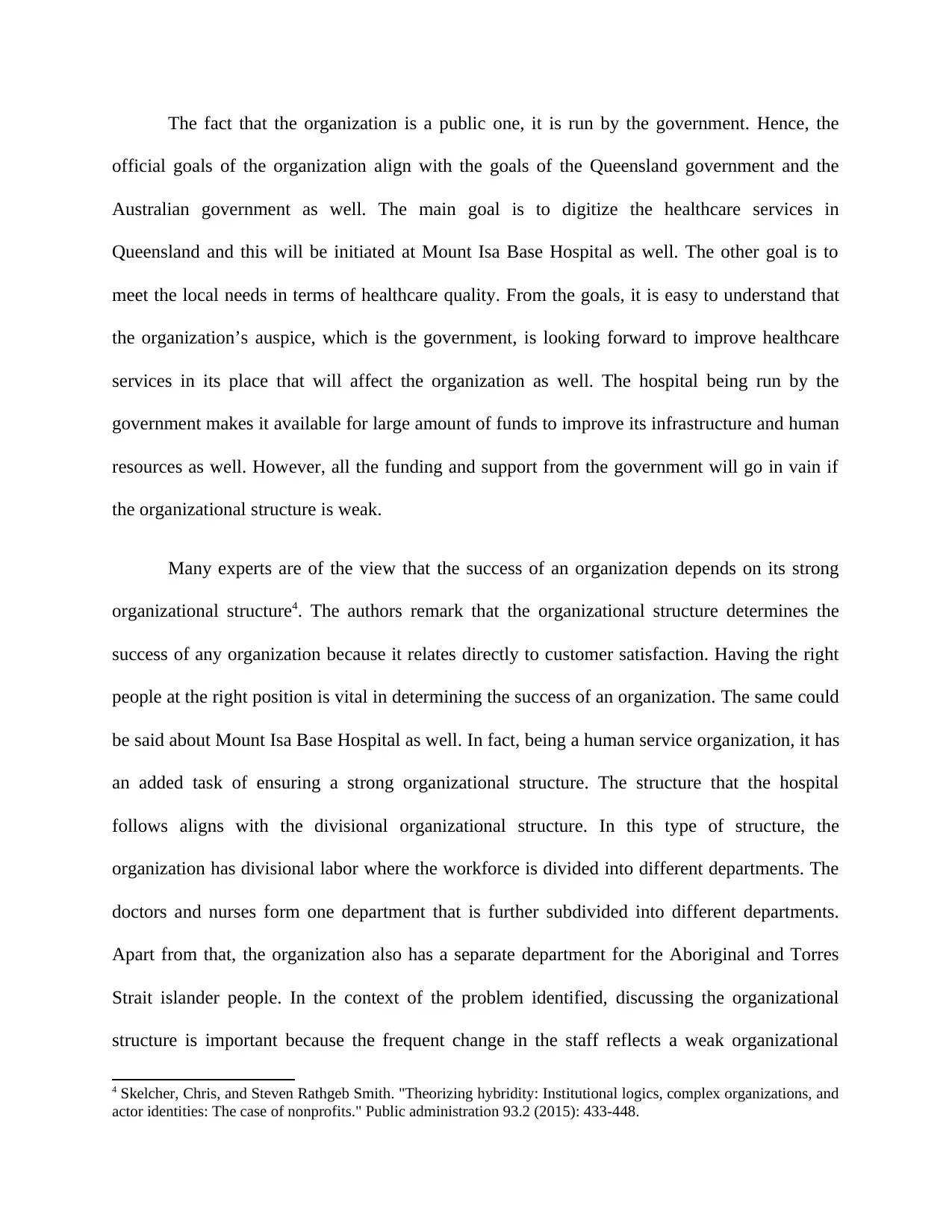
The fact that the organization is a public one, it is run by the government. Hence, the
official goals of the organization align with the goals of the Queensland government and the
Australian government as well. The main goal is to digitize the healthcare services in
Queensland and this will be initiated at Mount Isa Base Hospital as well. The other goal is to
meet the local needs in terms of healthcare quality. From the goals, it is easy to understand that
the organization’s auspice, which is the government, is looking forward to improve healthcare
services in its place that will affect the organization as well. The hospital being run by the
government makes it available for large amount of funds to improve its infrastructure and human
resources as well. However, all the funding and support from the government will go in vain if
the organizational structure is weak.
Many experts are of the view that the success of an organization depends on its strong
organizational structure4. The authors remark that the organizational structure determines the
success of any organization because it relates directly to customer satisfaction. Having the right
people at the right position is vital in determining the success of an organization. The same could
be said about Mount Isa Base Hospital as well. In fact, being a human service organization, it has
an added task of ensuring a strong organizational structure. The structure that the hospital
follows aligns with the divisional organizational structure. In this type of structure, the
organization has divisional labor where the workforce is divided into different departments. The
doctors and nurses form one department that is further subdivided into different departments.
Apart from that, the organization also has a separate department for the Aboriginal and Torres
Strait islander people. In the context of the problem identified, discussing the organizational
structure is important because the frequent change in the staff reflects a weak organizational
4 Skelcher, Chris, and Steven Rathgeb Smith. "Theorizing hybridity: Institutional logics, complex organizations, and
actor identities: The case of nonprofits." Public administration 93.2 (2015): 433-448.
official goals of the organization align with the goals of the Queensland government and the
Australian government as well. The main goal is to digitize the healthcare services in
Queensland and this will be initiated at Mount Isa Base Hospital as well. The other goal is to
meet the local needs in terms of healthcare quality. From the goals, it is easy to understand that
the organization’s auspice, which is the government, is looking forward to improve healthcare
services in its place that will affect the organization as well. The hospital being run by the
government makes it available for large amount of funds to improve its infrastructure and human
resources as well. However, all the funding and support from the government will go in vain if
the organizational structure is weak.
Many experts are of the view that the success of an organization depends on its strong
organizational structure4. The authors remark that the organizational structure determines the
success of any organization because it relates directly to customer satisfaction. Having the right
people at the right position is vital in determining the success of an organization. The same could
be said about Mount Isa Base Hospital as well. In fact, being a human service organization, it has
an added task of ensuring a strong organizational structure. The structure that the hospital
follows aligns with the divisional organizational structure. In this type of structure, the
organization has divisional labor where the workforce is divided into different departments. The
doctors and nurses form one department that is further subdivided into different departments.
Apart from that, the organization also has a separate department for the Aboriginal and Torres
Strait islander people. In the context of the problem identified, discussing the organizational
structure is important because the frequent change in the staff reflects a weak organizational
4 Skelcher, Chris, and Steven Rathgeb Smith. "Theorizing hybridity: Institutional logics, complex organizations, and
actor identities: The case of nonprofits." Public administration 93.2 (2015): 433-448.
Paraphrase This Document
Need a fresh take? Get an instant paraphrase of this document with our AI Paraphraser

structure. As I have mentioned previously, the hospital suffers from the problem of stability
where most of its staff changes in a span of less than six months.
The context of the culture plays a very essential role within the organization since the
shared and the cultural aspect of this organizational life tends to have major bearing on the
outcomes of the organization. The issues highlighted above are mainly because of the complexity
existing among the health care cultures and the ambiguity existing around the success of this
health care organization. The organizational structure of this particular organization in discussion
is weak because the flow of communication is mostly one way. In the views of some, while
emphasizing the role of internet communication in organizations today, states that the internet
strengthens organizations by making available the data with easy access5. In this way, every
department of the organization could be in contact without any chances of miscommunication or
one-way communication. This would in turn strengthen the organizational structure.
Direct and indirect task environments mean the internal and external environments that
affect the overall functioning of an organization. In case of Mount Isa Base Hospital, the direct
or internal task environment includes the doctors, counselors, nurses and social workers who
bring in patients with financial or other constraints. The indirect environment includes the
patients, the government stakeholders and the entire Aboriginal community of Mount Isa. The
two task environments are related to the identified problem because instability in the
organization affects both the direct and indirect task environments. When the doctors, counselors
and other staff including the social workers are changed so frequently, it affects the usual
business at the organization. Another important thing to notice is that most of patients visiting
5 Eimhjellen, Ivar Sognnæs. "Internet communication: Does it strengthen local voluntary organizations?." Nonprofit
and Voluntary Sector Quarterly 43.5 (2014): 890-909.
where most of its staff changes in a span of less than six months.
The context of the culture plays a very essential role within the organization since the
shared and the cultural aspect of this organizational life tends to have major bearing on the
outcomes of the organization. The issues highlighted above are mainly because of the complexity
existing among the health care cultures and the ambiguity existing around the success of this
health care organization. The organizational structure of this particular organization in discussion
is weak because the flow of communication is mostly one way. In the views of some, while
emphasizing the role of internet communication in organizations today, states that the internet
strengthens organizations by making available the data with easy access5. In this way, every
department of the organization could be in contact without any chances of miscommunication or
one-way communication. This would in turn strengthen the organizational structure.
Direct and indirect task environments mean the internal and external environments that
affect the overall functioning of an organization. In case of Mount Isa Base Hospital, the direct
or internal task environment includes the doctors, counselors, nurses and social workers who
bring in patients with financial or other constraints. The indirect environment includes the
patients, the government stakeholders and the entire Aboriginal community of Mount Isa. The
two task environments are related to the identified problem because instability in the
organization affects both the direct and indirect task environments. When the doctors, counselors
and other staff including the social workers are changed so frequently, it affects the usual
business at the organization. Another important thing to notice is that most of patients visiting
5 Eimhjellen, Ivar Sognnæs. "Internet communication: Does it strengthen local voluntary organizations?." Nonprofit
and Voluntary Sector Quarterly 43.5 (2014): 890-909.
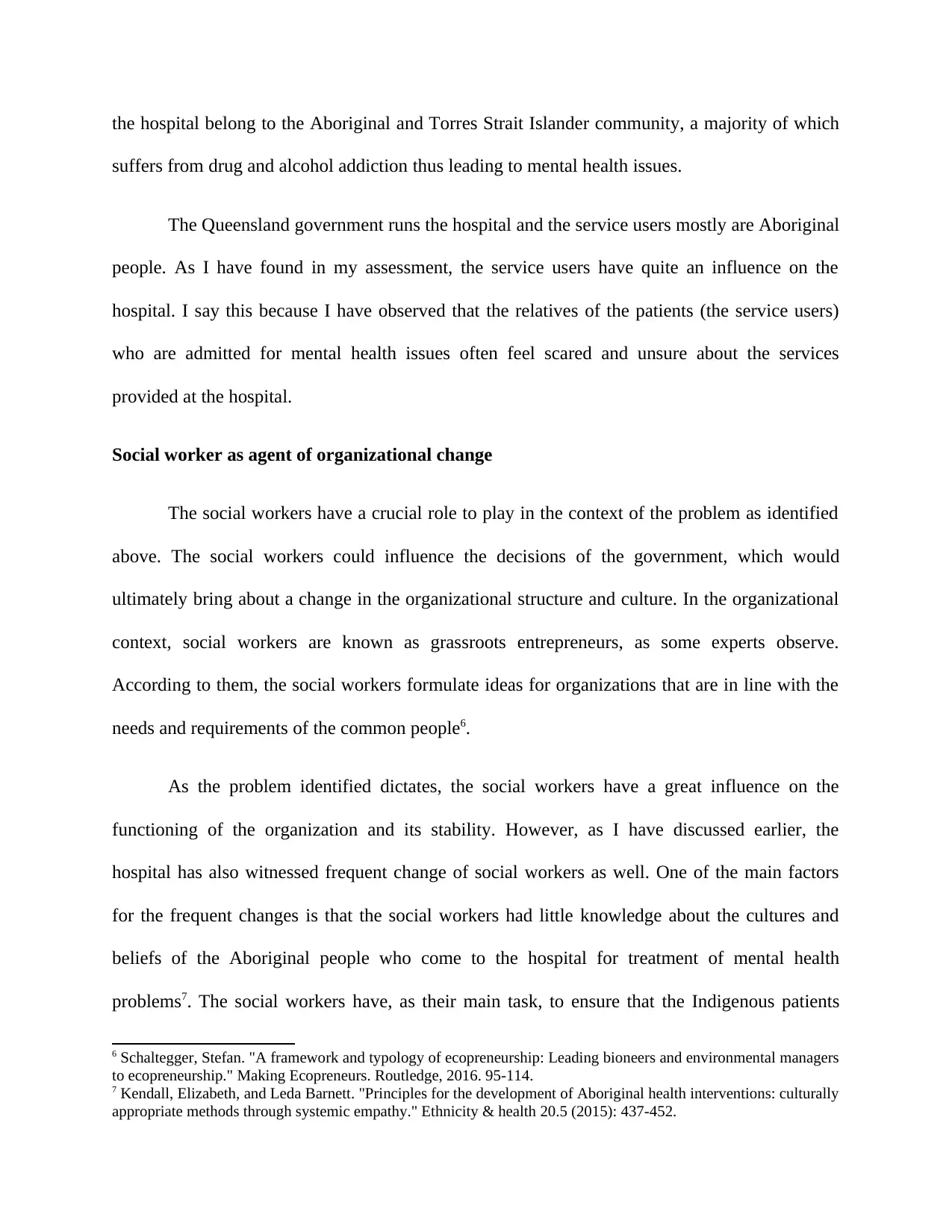
the hospital belong to the Aboriginal and Torres Strait Islander community, a majority of which
suffers from drug and alcohol addiction thus leading to mental health issues.
The Queensland government runs the hospital and the service users mostly are Aboriginal
people. As I have found in my assessment, the service users have quite an influence on the
hospital. I say this because I have observed that the relatives of the patients (the service users)
who are admitted for mental health issues often feel scared and unsure about the services
provided at the hospital.
Social worker as agent of organizational change
The social workers have a crucial role to play in the context of the problem as identified
above. The social workers could influence the decisions of the government, which would
ultimately bring about a change in the organizational structure and culture. In the organizational
context, social workers are known as grassroots entrepreneurs, as some experts observe.
According to them, the social workers formulate ideas for organizations that are in line with the
needs and requirements of the common people6.
As the problem identified dictates, the social workers have a great influence on the
functioning of the organization and its stability. However, as I have discussed earlier, the
hospital has also witnessed frequent change of social workers as well. One of the main factors
for the frequent changes is that the social workers had little knowledge about the cultures and
beliefs of the Aboriginal people who come to the hospital for treatment of mental health
problems7. The social workers have, as their main task, to ensure that the Indigenous patients
6 Schaltegger, Stefan. "A framework and typology of ecopreneurship: Leading bioneers and environmental managers
to ecopreneurship." Making Ecopreneurs. Routledge, 2016. 95-114.
7 Kendall, Elizabeth, and Leda Barnett. "Principles for the development of Aboriginal health interventions: culturally
appropriate methods through systemic empathy." Ethnicity & health 20.5 (2015): 437-452.
suffers from drug and alcohol addiction thus leading to mental health issues.
The Queensland government runs the hospital and the service users mostly are Aboriginal
people. As I have found in my assessment, the service users have quite an influence on the
hospital. I say this because I have observed that the relatives of the patients (the service users)
who are admitted for mental health issues often feel scared and unsure about the services
provided at the hospital.
Social worker as agent of organizational change
The social workers have a crucial role to play in the context of the problem as identified
above. The social workers could influence the decisions of the government, which would
ultimately bring about a change in the organizational structure and culture. In the organizational
context, social workers are known as grassroots entrepreneurs, as some experts observe.
According to them, the social workers formulate ideas for organizations that are in line with the
needs and requirements of the common people6.
As the problem identified dictates, the social workers have a great influence on the
functioning of the organization and its stability. However, as I have discussed earlier, the
hospital has also witnessed frequent change of social workers as well. One of the main factors
for the frequent changes is that the social workers had little knowledge about the cultures and
beliefs of the Aboriginal people who come to the hospital for treatment of mental health
problems7. The social workers have, as their main task, to ensure that the Indigenous patients
6 Schaltegger, Stefan. "A framework and typology of ecopreneurship: Leading bioneers and environmental managers
to ecopreneurship." Making Ecopreneurs. Routledge, 2016. 95-114.
7 Kendall, Elizabeth, and Leda Barnett. "Principles for the development of Aboriginal health interventions: culturally
appropriate methods through systemic empathy." Ethnicity & health 20.5 (2015): 437-452.
⊘ This is a preview!⊘
Do you want full access?
Subscribe today to unlock all pages.

Trusted by 1+ million students worldwide
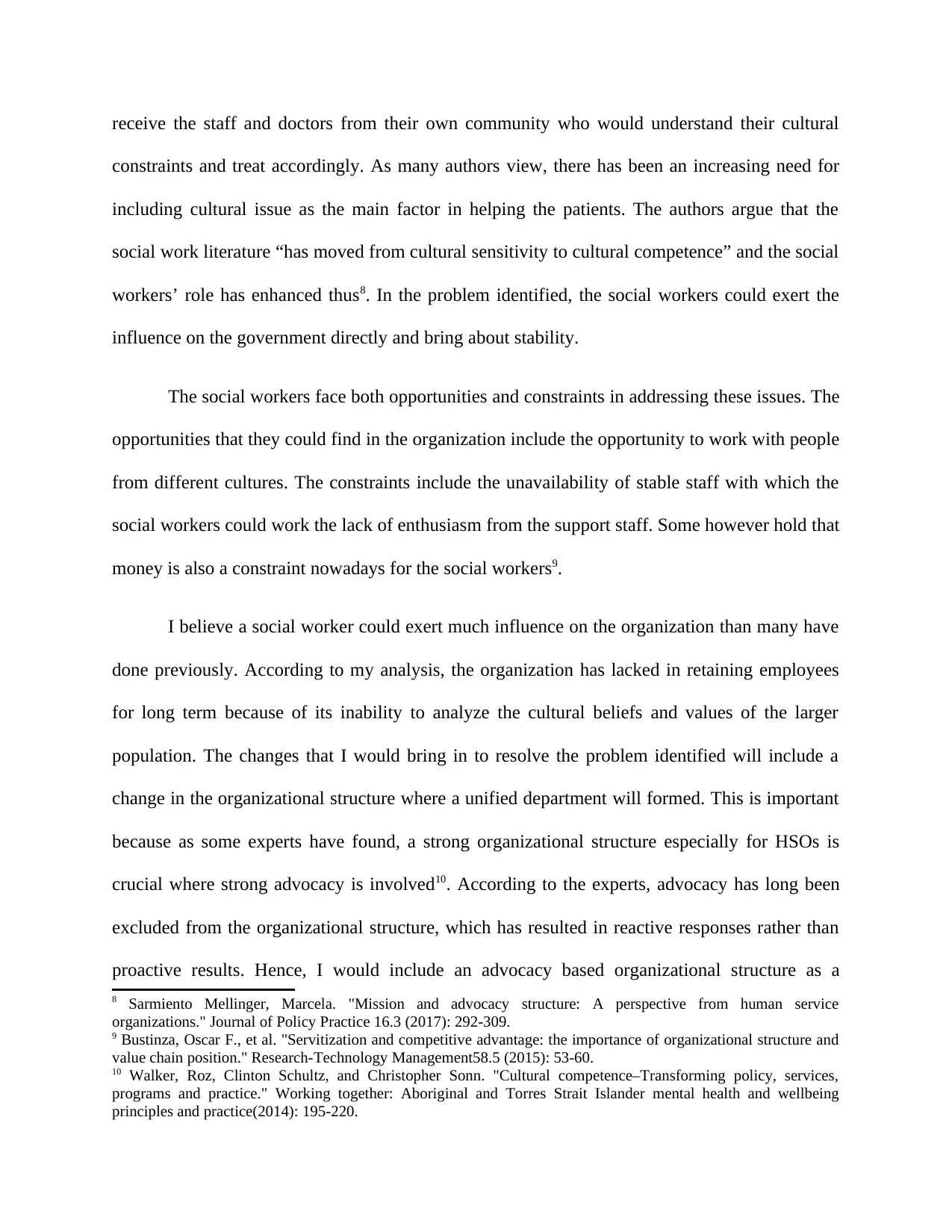
receive the staff and doctors from their own community who would understand their cultural
constraints and treat accordingly. As many authors view, there has been an increasing need for
including cultural issue as the main factor in helping the patients. The authors argue that the
social work literature “has moved from cultural sensitivity to cultural competence” and the social
workers’ role has enhanced thus8. In the problem identified, the social workers could exert the
influence on the government directly and bring about stability.
The social workers face both opportunities and constraints in addressing these issues. The
opportunities that they could find in the organization include the opportunity to work with people
from different cultures. The constraints include the unavailability of stable staff with which the
social workers could work the lack of enthusiasm from the support staff. Some however hold that
money is also a constraint nowadays for the social workers9.
I believe a social worker could exert much influence on the organization than many have
done previously. According to my analysis, the organization has lacked in retaining employees
for long term because of its inability to analyze the cultural beliefs and values of the larger
population. The changes that I would bring in to resolve the problem identified will include a
change in the organizational structure where a unified department will formed. This is important
because as some experts have found, a strong organizational structure especially for HSOs is
crucial where strong advocacy is involved10. According to the experts, advocacy has long been
excluded from the organizational structure, which has resulted in reactive responses rather than
proactive results. Hence, I would include an advocacy based organizational structure as a
8 Sarmiento Mellinger, Marcela. "Mission and advocacy structure: A perspective from human service
organizations." Journal of Policy Practice 16.3 (2017): 292-309.
9 Bustinza, Oscar F., et al. "Servitization and competitive advantage: the importance of organizational structure and
value chain position." Research-Technology Management58.5 (2015): 53-60.
10 Walker, Roz, Clinton Schultz, and Christopher Sonn. "Cultural competence–Transforming policy, services,
programs and practice." Working together: Aboriginal and Torres Strait Islander mental health and wellbeing
principles and practice(2014): 195-220.
constraints and treat accordingly. As many authors view, there has been an increasing need for
including cultural issue as the main factor in helping the patients. The authors argue that the
social work literature “has moved from cultural sensitivity to cultural competence” and the social
workers’ role has enhanced thus8. In the problem identified, the social workers could exert the
influence on the government directly and bring about stability.
The social workers face both opportunities and constraints in addressing these issues. The
opportunities that they could find in the organization include the opportunity to work with people
from different cultures. The constraints include the unavailability of stable staff with which the
social workers could work the lack of enthusiasm from the support staff. Some however hold that
money is also a constraint nowadays for the social workers9.
I believe a social worker could exert much influence on the organization than many have
done previously. According to my analysis, the organization has lacked in retaining employees
for long term because of its inability to analyze the cultural beliefs and values of the larger
population. The changes that I would bring in to resolve the problem identified will include a
change in the organizational structure where a unified department will formed. This is important
because as some experts have found, a strong organizational structure especially for HSOs is
crucial where strong advocacy is involved10. According to the experts, advocacy has long been
excluded from the organizational structure, which has resulted in reactive responses rather than
proactive results. Hence, I would include an advocacy based organizational structure as a
8 Sarmiento Mellinger, Marcela. "Mission and advocacy structure: A perspective from human service
organizations." Journal of Policy Practice 16.3 (2017): 292-309.
9 Bustinza, Oscar F., et al. "Servitization and competitive advantage: the importance of organizational structure and
value chain position." Research-Technology Management58.5 (2015): 53-60.
10 Walker, Roz, Clinton Schultz, and Christopher Sonn. "Cultural competence–Transforming policy, services,
programs and practice." Working together: Aboriginal and Torres Strait Islander mental health and wellbeing
principles and practice(2014): 195-220.
Paraphrase This Document
Need a fresh take? Get an instant paraphrase of this document with our AI Paraphraser
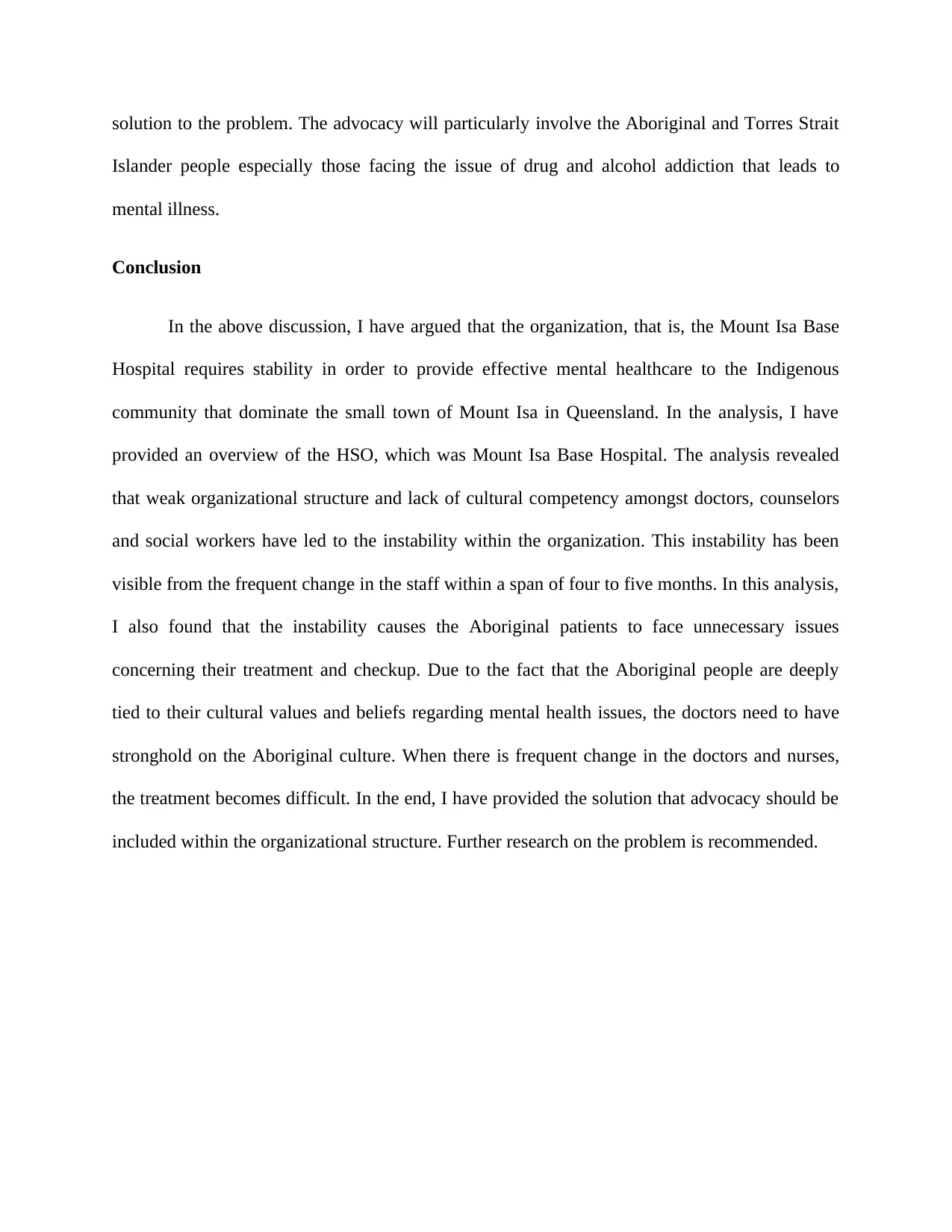
solution to the problem. The advocacy will particularly involve the Aboriginal and Torres Strait
Islander people especially those facing the issue of drug and alcohol addiction that leads to
mental illness.
Conclusion
In the above discussion, I have argued that the organization, that is, the Mount Isa Base
Hospital requires stability in order to provide effective mental healthcare to the Indigenous
community that dominate the small town of Mount Isa in Queensland. In the analysis, I have
provided an overview of the HSO, which was Mount Isa Base Hospital. The analysis revealed
that weak organizational structure and lack of cultural competency amongst doctors, counselors
and social workers have led to the instability within the organization. This instability has been
visible from the frequent change in the staff within a span of four to five months. In this analysis,
I also found that the instability causes the Aboriginal patients to face unnecessary issues
concerning their treatment and checkup. Due to the fact that the Aboriginal people are deeply
tied to their cultural values and beliefs regarding mental health issues, the doctors need to have
stronghold on the Aboriginal culture. When there is frequent change in the doctors and nurses,
the treatment becomes difficult. In the end, I have provided the solution that advocacy should be
included within the organizational structure. Further research on the problem is recommended.
Islander people especially those facing the issue of drug and alcohol addiction that leads to
mental illness.
Conclusion
In the above discussion, I have argued that the organization, that is, the Mount Isa Base
Hospital requires stability in order to provide effective mental healthcare to the Indigenous
community that dominate the small town of Mount Isa in Queensland. In the analysis, I have
provided an overview of the HSO, which was Mount Isa Base Hospital. The analysis revealed
that weak organizational structure and lack of cultural competency amongst doctors, counselors
and social workers have led to the instability within the organization. This instability has been
visible from the frequent change in the staff within a span of four to five months. In this analysis,
I also found that the instability causes the Aboriginal patients to face unnecessary issues
concerning their treatment and checkup. Due to the fact that the Aboriginal people are deeply
tied to their cultural values and beliefs regarding mental health issues, the doctors need to have
stronghold on the Aboriginal culture. When there is frequent change in the doctors and nurses,
the treatment becomes difficult. In the end, I have provided the solution that advocacy should be
included within the organizational structure. Further research on the problem is recommended.

References:
Bustinza, Oscar F., et al. "Servitization and competitive advantage: the importance of
organizational structure and value chain position." Research-Technology Management58.5
(2015): 53-60.
Carnochan, Sarah, et al. "Performance measurement challenges in nonprofit human service
organizations." Nonprofit and Voluntary Sector Quarterly 43.6 (2014): 1014-1032.
Eimhjellen, Ivar Sognnæs. "Internet communication: Does it strengthen local voluntary
organizations?." Nonprofit and Voluntary Sector Quarterly 43.5 (2014): 890-909.
Freeman, Toby, et al. "Cultural respect strategies in Australian Aboriginal primary health care
services: beyond education and training of practitioners." Australian and New Zealand Journal
of Public Health 38.4 (2014): 355-361.
Kendall, Elizabeth, and Leda Barnett. "Principles for the development of Aboriginal health
interventions: culturally appropriate methods through systemic empathy." Ethnicity &
health 20.5 (2015): 437-452.
Myhospitals.gov.au, "Mount Isa Base Hospital |
Myhospitals.Gov.Au", Myhospitals.Gov.Au (Webpage, 2019)
https://www.myhospitals.gov.au/hospital/310000246/mount-isa-base-hospital
Sarmiento Mellinger, Marcela. "Mission and advocacy structure: A perspective from human
service organizations." Journal of Policy Practice 16.3 (2017): 292-309.
Schaltegger, Stefan. "A framework and typology of ecopreneurship: Leading bioneers and
environmental managers to ecopreneurship." Making Ecopreneurs. Routledge, 2016. 95-114.
Bustinza, Oscar F., et al. "Servitization and competitive advantage: the importance of
organizational structure and value chain position." Research-Technology Management58.5
(2015): 53-60.
Carnochan, Sarah, et al. "Performance measurement challenges in nonprofit human service
organizations." Nonprofit and Voluntary Sector Quarterly 43.6 (2014): 1014-1032.
Eimhjellen, Ivar Sognnæs. "Internet communication: Does it strengthen local voluntary
organizations?." Nonprofit and Voluntary Sector Quarterly 43.5 (2014): 890-909.
Freeman, Toby, et al. "Cultural respect strategies in Australian Aboriginal primary health care
services: beyond education and training of practitioners." Australian and New Zealand Journal
of Public Health 38.4 (2014): 355-361.
Kendall, Elizabeth, and Leda Barnett. "Principles for the development of Aboriginal health
interventions: culturally appropriate methods through systemic empathy." Ethnicity &
health 20.5 (2015): 437-452.
Myhospitals.gov.au, "Mount Isa Base Hospital |
Myhospitals.Gov.Au", Myhospitals.Gov.Au (Webpage, 2019)
https://www.myhospitals.gov.au/hospital/310000246/mount-isa-base-hospital
Sarmiento Mellinger, Marcela. "Mission and advocacy structure: A perspective from human
service organizations." Journal of Policy Practice 16.3 (2017): 292-309.
Schaltegger, Stefan. "A framework and typology of ecopreneurship: Leading bioneers and
environmental managers to ecopreneurship." Making Ecopreneurs. Routledge, 2016. 95-114.
⊘ This is a preview!⊘
Do you want full access?
Subscribe today to unlock all pages.

Trusted by 1+ million students worldwide
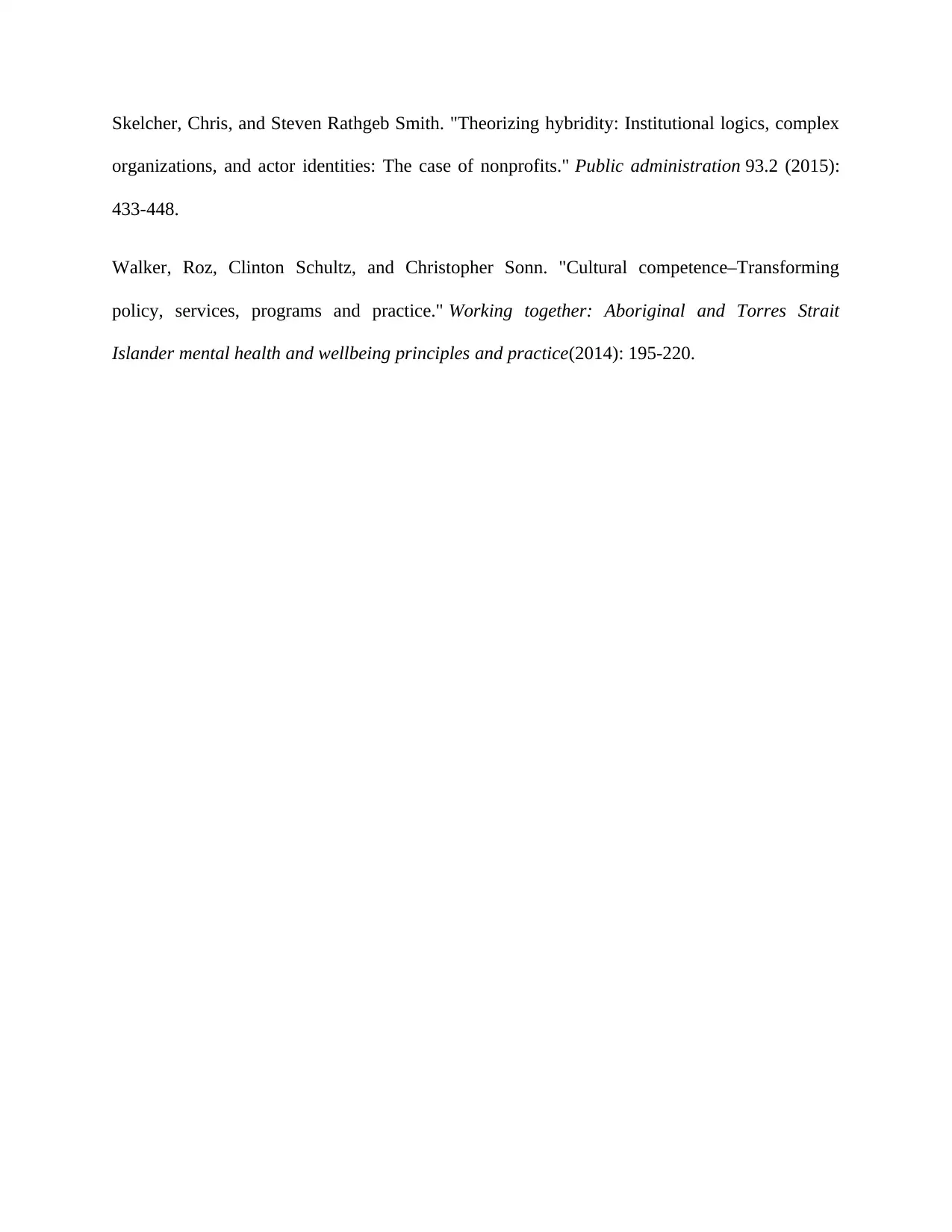
Skelcher, Chris, and Steven Rathgeb Smith. "Theorizing hybridity: Institutional logics, complex
organizations, and actor identities: The case of nonprofits." Public administration 93.2 (2015):
433-448.
Walker, Roz, Clinton Schultz, and Christopher Sonn. "Cultural competence–Transforming
policy, services, programs and practice." Working together: Aboriginal and Torres Strait
Islander mental health and wellbeing principles and practice(2014): 195-220.
organizations, and actor identities: The case of nonprofits." Public administration 93.2 (2015):
433-448.
Walker, Roz, Clinton Schultz, and Christopher Sonn. "Cultural competence–Transforming
policy, services, programs and practice." Working together: Aboriginal and Torres Strait
Islander mental health and wellbeing principles and practice(2014): 195-220.
1 out of 10
Related Documents
Your All-in-One AI-Powered Toolkit for Academic Success.
+13062052269
info@desklib.com
Available 24*7 on WhatsApp / Email
![[object Object]](/_next/static/media/star-bottom.7253800d.svg)
Unlock your academic potential
Copyright © 2020–2025 A2Z Services. All Rights Reserved. Developed and managed by ZUCOL.





